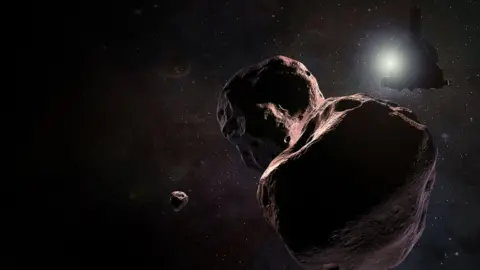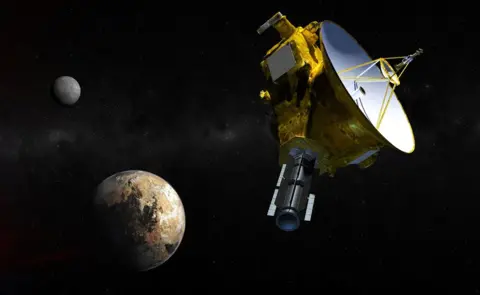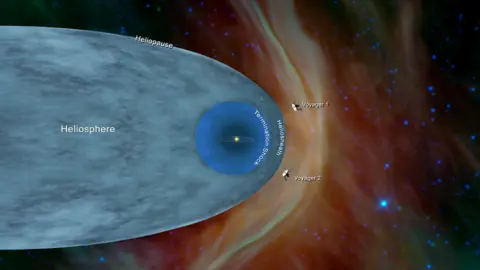Nasa's New Horizons probe on course for historic flyby
 NASA
NASAThe American space agency's New Horizons probe remains on course for its daring flyby of Ultima Thule.
When the mission sweeps past the 30km wide object on New Year's Day, it will be making the most distant ever visit to a Solar System body - at some 6.5 billion km from Earth.
Mission planners decided at the weekend to forego a possible trajectory change.
It means the probe will get to fly 3,500km from icy Ultima's surface to take a series of photos and other data.
There had been some concern that the object might be surrounded by large debris particles which could destroy the probe if it were to run into them. But nothing of the sort has been detected and so a wider, safer pass will not be needed.
 NASA/JH-APL/SWRI
NASA/JH-APL/SWRIIt is now three years since New Horizons made its remarkable flyby of dwarf planet Pluto. That was a technical tour de force and acquiring observations at Ultima will be just as tricky.
Controllers will have to tell the spacecraft precisely where and when to point its instruments or risk sensing empty space as it hurtles by at 51,000km/h.
"Can we fly 3,500km from the object and get all those images centred right on to the target, and not miss anything? That's the excitement for me; that's the challenge," said Mission Operations Manager Alice Bowman at last week's American Geophysical Union Fall Meeting in Washington DC.
New Horizons will be sending back repeat images of Ultima in the coming days that will help refine the final navigation and timing models used during the flyby.

Other stories from the AGU meeting you might like:

 NASA
NASAWhat do we know about Ultima Thule?
Very little. The object was only discovered four years ago by the Hubble telescope in a search for potential targets that New Horizons could reach after its Pluto encounter.
Initially catalogued as (486958) 2014 MU69, it was given the more catchy nickname of Ultima Thule (Pronounced: Too-lee) after a public consultation exercise.
Like many Kuiper belt objects of its type, it is likely to be composed of dust and ices that came together at the dawn of the Solar System more than 4.5 billion years ago.
Theory suggests such bodies will take on an elongated or lobate form. Think potato or peanut.
Its surface should be very dark, having being "burnt" through the eons by high-energy radiation - cosmic rays and X-rays.
New Horizons will study Ultima's shape, composition and environment.
Scientists hope Ultima can provide insights on how these distant objects formed. One idea is that they grew from the mass accretion of a great many pebble-sized grains.
 NASA
NASAWhat can we expect from the flyby?
Don't blink, you might miss it. Unlike the encounter with Pluto in July 2015, there won't be increasingly resolved images on approach to admire. Ultima will remain a blob in the viewfinder pretty much until the day of flyby, which has 05:33 GMT set as the time of closest approach.
However, the much reduced separation between the probe and Ultima (3,500km versus 12,500km at the dwarf planet) means that finer detail in the surface will eventually be observed.
The "mouthwatering" phase of the pass occurs in a roughly 48-hour period, centred mostly on the day-side of the object. Because New Horizons has to swivel to point its instruments, it cannot keep its antenna locked on Earth while also gathering data.
Controllers must therefore wait until later on New Year's Day for the probe to "phone home" a status update and to start to downlink some choice pictures.
And it will be 2 January before we see the first of these images, and 3 January before we get the best.
At a distance of 6.5 billion km, radio signals take over six hours to reach Earth.
"Our data rates are low - typical data rates max out around 1,000 bits a second and it's going to take 20 months to get it all back," explained New Horizons Principal Investigator Alan Stern. "Which is kinda cool because we'll be getting new presents from the Kuiper belt every week and every month though 2019 and most of 2020," he told BBC News.
 NASA/JPL
NASA/JPLWhat does New Horizons do afterwards?
The team working on the probe is going ask Nasa to fund an extended mission.
The hope is that the course of the spacecraft can be altered to visit at least one more Kuiper belt object sometime in the next decade.
It has just enough fuel reserves to be able to do this. Critically, it has sufficient electrical reserves to keep operating its instruments through this period, too.
New Horizon's plutonium battery may even allow it to keep talking to Earth as it leaves the Solar System.
The two 1970s Voyager missions have both now exited the heliosphere - the bubble of gas blown off our Sun. Voyager 2 has only recently done it, in November.
This occurred at a distance of 119 Astronomical Units (or 119 times the Earth-Sun distance, 149 million km). New Horizons is currently at 44 AU and clocking about three additional AU every year.
Its power system could probably run to about 100 AU, said Prof Stern.
"That's less than the Voyagers' distance but the interesting game is that the heliosphere breathes in and out by tens of astronomical units because of the solar cycle," he explained.
"No-one is good enough at predicting the solar cycle to tell you where the edge of the heliosphere will be in the mid-late 2030s when we go power-critical."

The BBC's Sky At Night programme will broadcast a special episode on the flyby on Sunday 13 January on BBC Four at 22:30 GMT. Presenter Chris Lintott will review the event and discuss some of the new science to emerge from the encounter with the New Horizons team.
[email protected] and follow me on Twitter: @BBCAmos
